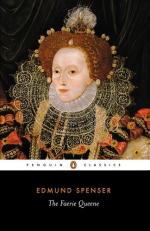72. THE CYPRESSE FUNERALL, an emblem of death among the ancients, and sacred to Pluto. Sidney says that they were wont to dress graves with cypress branches in old times.
73. THE LAURELL. Victors at the Pythian games and triumphing Roman generals were crowned with laurel. It was also sacred to Apollo, the god of poetry, hence “meed of poets sage.”
74. THE FIRRE THAT WEEPETH STILL. The fir exudes resinous substance.
75. THE WILLOW. “Willows: a sad tree, whereof such who have lost their love make their mourning garlands.”—Fuller’s Worthies, i, 153. Cf. Heywood’s Song of the Green Willow, and Desdemona’s song in Othello, IV, iii, 39.
76. THE EUGH. Ascham in his Toxophilus tells us that the best bows were made of yew.
78. THE MIRRHE, the Arabian myrtle, which exudes a bitter but fragrant gum. The allusion is to the wounding of Myrrha by her father and her metamorphosis into this tree.
79. THE WARLIKE BEECH, because lances and other arms were made of it. THE ASH FOR NOTHING ILL. “The uses of the ash is one of the most universal: it serves the souldier, the carpenter, the wheelwright, cartwright, cooper, turner, and thatcher.”—Evelyn’s Sylva. The great tree Igdrasil in the northern mythology was an ash.
81. THE CARVER HOLME, or evergreen oak, was good for carving.
106. SHAME WERE TO REVOKE, etc., it would be cowardly not to go forward for fear of some suspected unseen danger.
114. THE WANDRING WOOD, i.e. which causes men to go astray.
123. MONSTER. The description of the monster Error, or Falsehood, is based on Hesiod’s Echidna, Theog. 301, and the locusts in Revelation, ix, 7-10. She is half human, half serpent, because error is partly true and partly false. Dante’s Fraud and Milton’s Sin are similar monsters.
126. FULL OF VILE DISDAINE, full of vileness that bred disgust in the beholder.
130. OF HER THERE BRED, etc., of her were born a thousand young ones. Her offspring are lies and rumors of many shapes.
141. ARMED TO POINT, completely armed. Cf. Fr. a point, to a nicety.
145. THE VALIANT ELFE, because he was the reputed son of an Elfin or Faerie, though really sprung from “an ancient race of Saxon kings.” Three kinds of elves are mentioned in the Edda: the black dwarfs, and brownies, who both dwelt under ground, and the fair elves, who dwelt in Fairyland or Alfheim. “The difference between Spenser’s elves and these Teutonic elves shows how he perverts Fairy mythology in the same way as he does Classical myths.”—Percival.
168. HIS GALL DID GRATE FOR GRIEFE, his anger was aroused on account of pain. In the old anatomy anger had its seat in the gallbladder. See Burton’s Anatomy of Melancholy, I, i, 2.
177. HER VOMIT FULL OF BOOKES, etc. From 1570, when Pope Sixtus V issued his bull of deposition against Queen Elizabeth, to 1590, great numbers of scurrilous pamphlets attacking the Queen and the Reformed church had been disseminated by Jesuit refugees.




